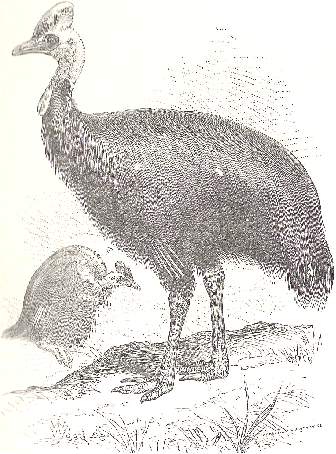|
|
|
Continued from Cassowary Habitat, Appearance and Claw Attacks
The legs of the Cassowary are extremely strong,
and can take the bird to a speed of up to 50 kilometers per hour.
The cassowary can and jump to a height of up to 1.5 meters. It is
also a good swimmer, crossing lakes and rivers without difficulty.
Cassowary are usually shy
birds that live deep within forests, and normally disappear from view long
before humans can detect them. Due to their secretive way of life
the habits of Cassowarys are not particularly well known. They are
solitary birds except during the breeding season which can be any time
between June and November when the fruits of the forest are more abundant.
Cassowary are essentially
sedentary birds, living in their territory for all the year. However, in
the dry season, movements can happen towards residual water pools or rivers
to search for
water to drink. They have
been known to travel great distances, due to the destruction of the habitats
in which they live.
It is believed that a Cassowary
can live quite a long life to the age of 40 or 50 years old.
|

Cassowary Picture
|
Courtship
The male's territory covers
an area of 1 to 5 km. If a female enters this area during the mating
season, the male starts a courtship display. The plumage is raised
up and the bird slowly circles. The neck is expanded, giving a particularly
bright appearance, and a dull “boo boo boo” call is spoken by the bird.
Nest, Eggs and Chicks
If the female has fallen for
the male's charms, after mating the pair will remain together for some
weeks. The female Cassowary lays her eggs in a bed of leaves and
grass in a shallow depression in wooded ground. The nest is always very
well hidden, camouflaged in the vegetation and very difficult to find.
The eggs are a lights bluish green colour, measuring approximately 9 to
14 centimetres. Only emus and the ostrich lay larger eggs. After
laying her eggs, the female leaves the nest. Often she then goes into the
area of another male, in order to mate with a new gentleman.
During one season she will probably mate with 2 or 3 males.
The male Cassowary who she
has left incubates the eggs, the incubation period being around 49 to 56
days. Only a few hours after hatching, the chicks can run around
after their father, who then takes care of the young chicks for about 9
months.
Young Cassowaries have a
brown plumage; the bright colors of the neck portions are missing to them.
Their helmet starts to become visible at around 6 months. During
their second year of life, Cassowaries gradually take the appearance of
adult birds and reach adult size. At the age of three and a half years
they are mature for mating.
|
Calls
Cassowarys producs a variety
of different sounds, according to their mood or of the activity that they
are carrying out. Today, little it is known about their meaning,
but during nesting the cassowary normally remains silent. They are
able to make particularly low calls, which lie around the lower borderlines
of human hearing. The Southern Cassowary can use calls as low
as at 23 hertz, and the Dwarf Cassowary 32 hertz. These sounds can
carry far and may help these solitary birds maintain contact with each
other. Other vocalisations include strong roars during combat, an
almost hissing-like sound. During the nine months in which the male
takes care of the chicks, he emits noises similar to coughing sounds.
|
|
|





